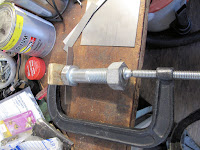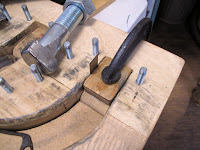The objective is to work out how tall of a hardwood block is needed under the steel so the steel hits the block just as the curved loop is long enough to form the finished rectangular shape. I think I'd rather be just a tiny bit short then being a little too long.
I clamped the "U" shaped piece in the form block against the original limiting block. With it securely clamped I gently hammered the legs down to the clamping surface of the form block.
I started by sheering 2 strips of 0.032" 1018 steel. It's cheaper to play with and the mechanical properties aren't that different from the 0.032" stainless.
I formed the first strip around the tool that I used for forming (hammering) the inlets in the form block. I drew some lines on the strips so I could align the tool close to the center of the strip.
I gently hammered the strip against the too to form the bottom of the "U" shape.
I clamped the "U" shaped piece in the form block against the original limiting block. With it securely clamped I gently hammered the legs down to the clamping surface of the form block.
Nicely formed without stretching the side walls. That's the goal for the 4 inlets in each shell half.
For figuring out the curved part I worked backwards. I held the squared piece against the forming tool and marked where the legs ended. This allowed me to clamp the second strip with each end aligned to it's mark. Then I folded each 90 degree bend around the tool.
The next step was to form the bend in the middle so it follows the curve of the tool I used to pound the metal into the form block.
For figuring out the curved part I worked backwards. I held the squared piece against the forming tool and marked where the legs ended. This allowed me to clamp the second strip with each end aligned to it's mark. Then I folded each 90 degree bend around the tool.
The next step was to form the bend in the middle so it follows the curve of the tool I used to pound the metal into the form block.
We're getting close to being finished with the piece back in the form block. I had marked the block so I could see that the flat legs are the correct length. Therefore the curved piece is the right length from bend to bend.
I put the clamping board back on and lightly tightened the nuts. Then I wiggled the square forming tool into the gap just enough to hold the metal corner bends tight to the block while tightening the clamping nuts.
OK, were ready to measure from the base board to the bottom of the bend. I used my Vernier to measure so it's really measuring to the top side of the bottom of the bend, therefore I need to subtract 0.032", the metal thickness, from my measurement.















No comments:
Post a Comment